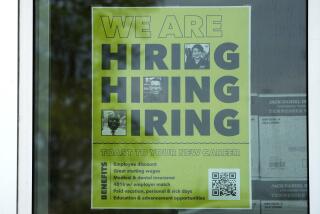Rise in Inventories Offers Further Proof of Rebound
U.S. business inventories rose in January for the first time in a year and jobless benefit claims declined for the fifth week in the last six, more signs the economy is rebounding from recession.
Inventories overall rose 0.2% for the month following a 0.5% December decline, the Commerce Department said. Meanwhile, combined sales at retailers, manufacturers and wholesalers climbed 1.1% in January, giving companies an incentive to boost production to further rebuild stocks.
“Those emptied shelves are getting replenished and that bodes well for manufacturers and the economy,” said Richard Yamarone, chief economist at Argus Research Corp. in New York. As production picks up, manufacturers won’t be as quick to fire workers, he said.
The number of people filing new claims for unemployment benefits fell by 3,000 to 377,000 last week, Labor Department statistics showed. The four-week moving average for jobless claims, a more reliable measure because it irons out weekly gyrations, edged up slightly to 374,750 from 373,750 a week earlier but remained substantially below levels seen earlier in the year.
Stockpiles at manufacturers, which account for about 40% of the inventories report, fell 0.6% in January, while factory sales jumped 2% for the month as customers ordered more goods. Factory inventories had fallen 0.9% in December.
At the wholesale level, inventories were down 0.2% in January as sales rose 1.2%. Inventories had fallen 0.5% in December.
The increase in total inventories in January occurred at the retail level: Inventories in that sector jumped 1.4% in the month, while sales eased 0.1%. Retail inventories had inched up 0.1% in December.
Stockpiles at auto dealers increased in January as sales declined. Inventories at clothing stores and department and other general merchandise stores also rose.
Separately, the Commerce Department said the U.S. current account deficit, the broadest measure of the nation’s trade because it includes investments, widened during the final three months of 2001 to $98.8 billion.
That was up slightly from $98.5billion in the third quarter and reflected smaller gains on services such as travel and insurance as well as fewer exports to weakened global markets as last year ended. But for the full year 2001, the current account gap narrowed for the first time in six years, to $417.4billion from $444.7billion in 2000.
*
Bloomberg News and Reuters were used in compiling this report.
More to Read
Inside the business of entertainment
The Wide Shot brings you news, analysis and insights on everything from streaming wars to production — and what it all means for the future.
You may occasionally receive promotional content from the Los Angeles Times.










